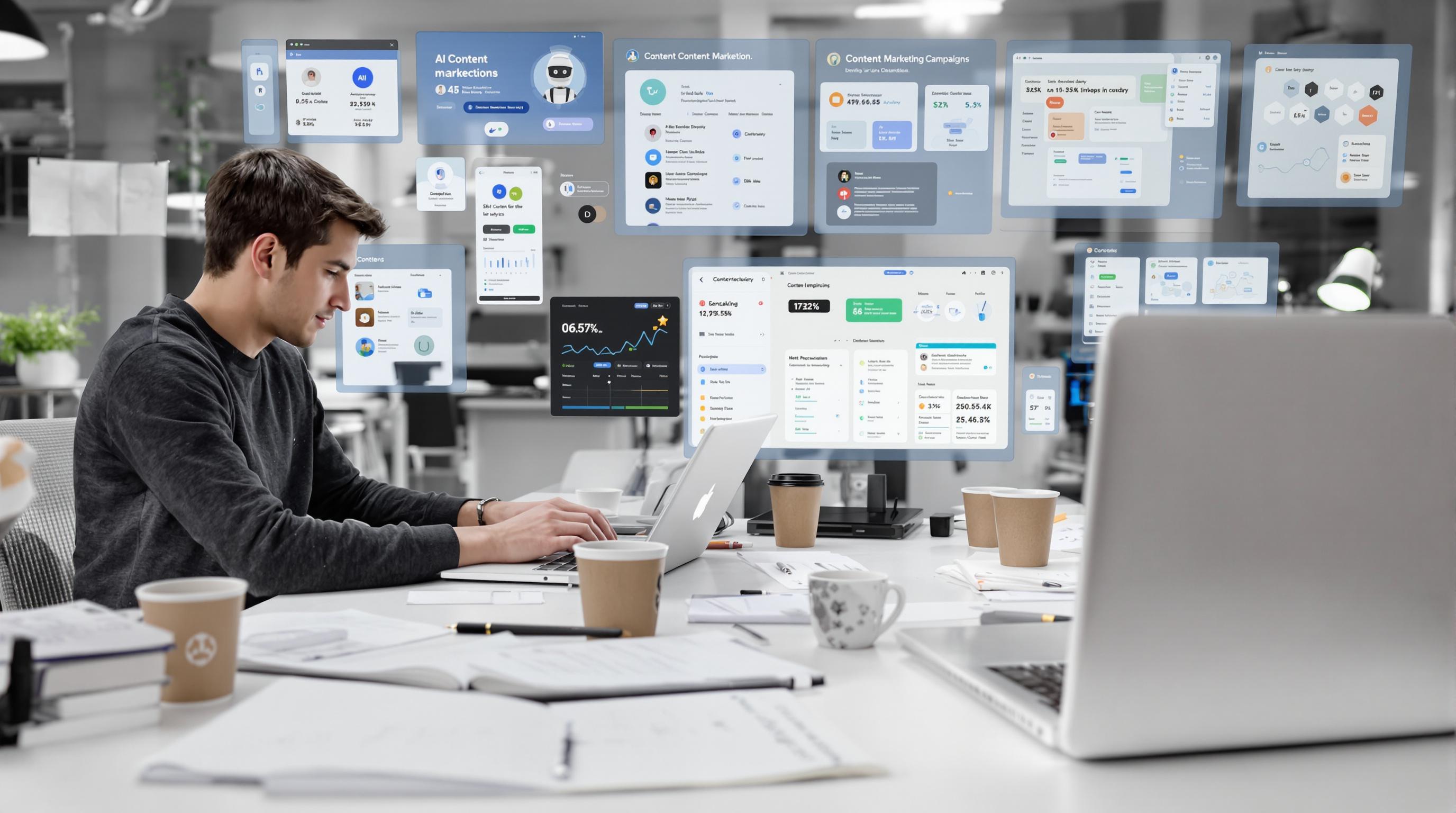How does AI really reshape marketing, and what lessons can we learn from its evolution? Dive in as we explore the transformation from linear programming to hyper-personalization.
The relationship between artificial intelligence and marketing has been a game-changer. It has created a ripple effect across industries, shifting how businesses approach their audiences, analyse data, and craft strategies. Yet, this transformation didn’t happen overnight. To appreciate its scope, we need to understand the history, current applications, and potential future of AI in marketing.
Understanding the history of AI in marketing
In the mid-20th century, the concept of AI was more theory than practice. Early researchers worked on applying models like linear programming, game theory, and decision trees to optimize marketing strategies. It was a time of rudimentary computer power and immense ambition. The groundwork they laid was essential. It created a base for tools we now consider indispensable.
As the 1970s and 1980s rolled in, the game began to change. The rise of expert systems and neural networks allowed businesses to analyse customer behaviour in ways that were previously impossible. AI started to predict what customers might want based on patterns and preferences. These systems were basic by today’s standards, but their ability to recommend a product or offer based on consumer data marked a pivotal moment in personalized marketing.
The internet boom of the 1990s and 2000s was like a turbocharger for AI in marketing. Suddenly, businesses had access to vast amounts of data. From tracking online clicks to mining search engine queries, marketers were able to glean insights that helped refine their tactics. Tools like web analytics and SEO started becoming industry standards, and AI’s role expanded from back-office optimization to customer-facing engagement.
Fast-forward to the 2010s and 2020s, where AI is in full bloom. Technologies such as deep learning, natural language processing, and computer vision are driving marketing strategies to new heights. AI isn’t just supporting campaigns, it’s actively designing them. From writing ad copy to analysing audience reactions, the possibilities seem endless.
Where AI stands today in marketing applications
Today, AI has permeated nearly every aspect of marketing. Its applications range from content creation to predictive analytics, and the results are often astounding.
One of the most impactful uses is in content creation and optimization. AI-driven tools like Gemini and ChatGPT have made generating blog posts, social media updates, and email campaigns faster and more efficient. But this isn’t just about speed. These tools optimize content for SEO, ensuring it ranks higher in search results and reaches the right audience.
Personalization is another standout area. Modern consumers expect brands to “know” them. AI delivers on this expectation by analysing user data to tailor advertisements, recommendations, and experiences. For example, a streaming service might use AI to suggest a movie that perfectly fits your recent viewing habits. Personalization is no longer a luxury in marketing—it’s a necessity.
AI has also supercharged marketing automation. Tasks like segmenting audiences, scheduling social media posts, and analysing campaign performance are streamlined through tools like HubSpot and others. These tools free marketers to focus on creativity and strategy, transforming how campaigns are executed.
In customer interaction, AI-powered chatbots are becoming the norm. They can answer queries, guide users through purchases, and even provide personalized recommendations. While effective, the challenge here lies in maintaining the balance between automated efficiency and the human touch.
Predictive analytics is where AI truly flexes its muscles. By analysing past data, AI can predict future trends and outcomes. This insight helps marketers allocate resources more effectively, identify opportunities, and mitigate risks.
Programmatic advertising is another key area. AI algorithms analyse user behaviour in real time, ensuring ads are displayed to the right audience. This level of precision makes every marketing dollar count.
Case studies: AI in action
Netflix provides one of the clearest examples of AI’s transformative power. Its recommendation engine analyses data like viewing habits and search patterns to deliver tailored suggestions. The platform even uses AI to decide which thumbnail to show each user, testing multiple variations to see which performs best.
Coca-Cola has explored AI in advertising by integrating artistic and cultural elements into campaigns. Their use of generative AI has created ads that feel both cutting-edge and on-brand, setting a standard for creative innovation.
The Messi Messages campaign exemplifies AI's ability to create memorable, personalized experiences. By leveraging natural language processing and voice synthesis, Lionel Messi sent personalized video messages to fans in multiple languages. This campaign highlighted how AI can make global marketing feel deeply personal.
What the future holds for AI in marketing
The evolution of AI is far from over. Emerging trends suggest that the relationship between AI and marketing will grow even deeper.
Hyper-personalization is on the horizon. Imagine ads and content tailored to not just your demographic, but your mood and real-time behaviour. AI will make this possible.
Content creation will reach new levels of realism. AI tools will generate videos and images that are indistinguishable from those made by humans. This shift will force brands to focus on storytelling and authenticity to stand out.
Real-time customer journey mapping will become a staple. Businesses will use AI to track interactions as they happen, enabling them to adjust their strategies on the fly.
AI will also provide deeper behavioural insights, allowing businesses to predict not just what consumers will do next, but why they’ll do it. This level of understanding could redefine how companies approach customer engagement.
Finally, marketing to non-human entities, like smart home devices, is on the rise. Brands will need to adapt their strategies to cater to these “machine customers.”
Challenges marketers must address
Despite its promise, AI comes with challenges. Ethical concerns around data privacy are paramount. Consumers are becoming increasingly wary of how their data is used, and brands must navigate these waters carefully.
The rapid pace of AI development also creates a skill gap. Marketers need ongoing training to keep up with evolving tools and techniques.
Another challenge is balancing automation with human creativity. While AI excels at efficiency, it’s the human element that builds emotional connections.
Finally, the effectiveness of AI hinges on data quality. Inaccurate or incomplete data can lead to flawed insights, undermining entire campaigns.
Conclusion
The journey of AI in marketing has been nothing short of revolutionary. From its roots in basic algorithms to its current role in driving hyper-personalized campaigns, AI has consistently expanded the boundaries of what’s possible. Yet, the path forward is as much about caution as it is about innovation. Ethical considerations, data quality, and the human touch will determine how effectively businesses can integrate AI into their strategies.
Brands that succeed will be those that use AI not as a crutch but as a tool, enhancing their ability to connect meaningfully with audiences. If AI is the engine, human creativity remains the fuel that drives marketing forward. The story of AI in marketing is still being written, and it’s clear that its best chapters are yet to come.
Recommended reading
https://www.linkedin.com/pulse/historical-evolution-ai-marketing-syed-jasminara
Definitions
- AI (Artificial Intelligence): The simulation of human intelligence in machines to perform tasks like learning and problem-solving.
- Neural Networks: Computing systems inspired by the human brain, used for pattern recognition and predictions.
- Personalization: Tailoring content or experiences to an individual's preferences and behavior.
- Predictive Analytics: Analyzing current and historical data to make predictions about future outcomes.
- Programmatic Advertising: Automated buying and placement of ads using AI to target specific audiences.
- Deep Learning: A subset of AI that uses neural networks with many layers to analyze complex patterns in data.
- Natural Language Processing (NLP): AI’s ability to understand, interpret, and respond to human language.
- Hyper-Personalization: An advanced form of personalization that uses real-time data and AI to deliver highly tailored experiences.




